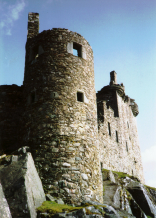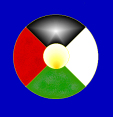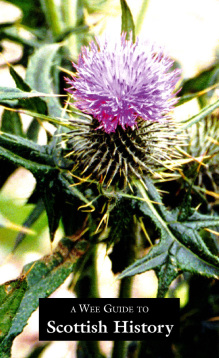Sons of Canmore
1066 Battle of Hastings
After William the Conqueror’s defeat of King Harold and the English, at Hastings in the south of England, many Anglo-Saxons settled in the south of Scotland at Malcolm Canmore’s invitation. Although Scotland was never conquered as England had been, the coming of the Normans had as profound an effect, reducing the Celtic influence, but strengthening the nation for the wars with the English in following centuries.
1068 Marriage of Malcolm Canmore to Margaret
In 1068 Malcolm Canmore married Margaret, sister of the Saxon heir to the throne of England, who had fled to Scotland with her brother. The marriage greatly angered William the Conqueror. Malcolm’s first wife, Ingibiorg, by whom he had had several children including a son Duncan, had recently died.
Margaret, whose chapel survives in Edinburgh Castle, preferred English ways to those of her Celtic subjects. Her sons were given English names, she practised European customs and culture at court, she encouraged monastic foundations, such as that at Dunfermline, of which the church still survives, and revived the monastery on Iona. This led to discontent amongst some of Malcolm’s subjects. Margaret, however, appears to have been a very pious woman, doing good works – according to her devoted biographer Turgot – and was later made a saint.
1072 William the Conqueror invades Scotland
Malcolm Canmore attacked England and ravaged Northumberland. William the Conqueror, angered by the attack and Malcolm’s marriage, invaded Scotland in 1072, forcing Canmore to pay homage to him. Malcolm responded with further raids into England, but in 1093 was treacherously murdered when accepting the surrender of Alnwick Castle, in Northumberland. Margaret died soon afterwards, at Edinburgh Castle, and she and Malcolm were buried in Dunfermline Abbey. Scotland was again plunged into dynastic turmoil.
1093 Donald Bane (Donald III), Duncan II & Edmund
Donald III, Donald Bane – Bane meaning ‘fair’ – the 60-year-old brother of Malcolm Canmore, seized the throne and drove out Margaret’s sons, partly because many resented the growing influence of the English and Normans. Donald was overthrown in turn in 1094 by Duncan II – Malcolm Canmore’s eldest son by his first wife Ingibiorg – with English help. However, Duncan was not popular and was murdered. Donald III recovered the throne, this time aided by Edmund, son of Malcolm and Margaret. Edgar, another of their sons, defeated Donald and Edmund, again with an English army. Donald was blinded and was imprisoned on Iona, while Edmund retired to a monastery in England.
1097-1107 Edgar the Peaceable & Alexander the Fierce
A time of relative peace, Edgar the Peaceable ruled Scotland well, although he ceded the Western Isles to the Norwegians, including Iona. Edgar did not marry and his brother, Alexander, succeeded him. Alexander earned his nickname The Fierce by savagely putting down a rising in Moray. However, he encouraged monastic settlements in Scotland, and founded Inchcolm Abbey, which is now an impressive ruin. He married Sibylla, an illegitimate daughter of Henry I of England. This match does not appear to have been happy, and Alexander died in 1124 without a son or daughter.
1124 David I
David I, brother of Alexander, came to the throne. He was married to Matilda, an English heiress, and David acquired the wealthy Earldom of Huntingdon in England, as well as other lands. He had spent many years in exile in England, and during this time had become friendly with many Norman families. He invited some of these men, with names such as Bruce, Comyn, and FitzAllan (Stewarts) to Scotland, and gave them land or married them to heiresses.
David also mostly ruled well, and burghs, with special trading privileges, were introduced. He founded abbeys at Holyrood, Edinburgh; Melrose; Dryburgh; Kelso; Newbattle, near Edinburgh; Kinloss; and Jedburgh. Melrose Abbey is a substantial ruin, as are Jedburgh and Dryburgh, while Holyrood Palace is built near the ruins of the old Abbey church. This increased the prosperity of the nation by encouraging trade and improving agriculture, although David had to put down rebellions in Moray in 1130, and in 1140.
1138 Battle of the Standard
David became involved in the fighting in England between Stephen of Blois and his niece, the rightful heir, Maud or Matilda. He invaded England on her behalf, but at the Battle of the Standard, near Northallerton, the Scots suffered a crushing defeat. However, David managed to acquire Northumberland and Cumberland in 1139 from the English when they were in disarray. The kingdom of Scots reached its furthest extent southwards. David died in 1153 at his prayers at Carlisle Castle.
1153 Malcolm the Maiden
Malcolm the Maiden, David’s grandson, came to the throne in 1153 when he was 11 years old. He was called the Maiden because he took a vow of celibacy and never married. Malcolm lost the Earldom of Northumberland, exchanging it for the Earldom of Huntingdon with Henry II of England. He put down risings in 1160 by Fergus, Earl of Galloway, in the south-west, as well as by Somerled.
Somerled had pushed the Norsemen out of much of the Hebrides between 1156-8, making himself an independent prince. He was assassinated at Renfrew before a battle with Malcolm’s forces. Somerled’s sons divided his lands, and it was from him that the MacDonalds and MacDougalls originated.
Malcolm the Maiden died at the age of 23 without children.
1174-1214 William the Lyon
William the Lyon, brother of Malcolm, became King of Scots in 1174. After putting down a rebellion in Galloway, William tried to recover Northumberland in 1175 and invaded the north of England. He was captured by the English at Alnwick, and was held at Falaise in Normandy until he swore fealty to Henry II of England as his overlord.
In 1176 William had the abbey at Arbroath built, in memory of his friend, Thomas Becket, who had been murdered in 1168. He brought the north of Scotland under his control during campaigns in 1179 and 1187, finally taking Caithness and Sutherland from Harald Maddadson, Earl of Orkney, who was blinded and castrated.
William restored Scotland’s independence in 1189 by paying Richard the Lionheart 10 000 merks. During his reign the Scottish church was recognised by the Pope as being separate from that of the English.
He was married in 1186 to Ermengarde de Beaumont, and they had a son, Alexander, as well as three daughters. William died in 1214.
The lion rampant was used as a heraldic device by Scottish kings, and may have been introduced by William. It is still used on the Scottish Standard by the current monarch.
1214-49 Alexander II
Alexander II, son of William the Lyon, came to the throne in 1214. Again he had to put down rebellions in Argyll, Caithness and Galloway, building castles at Tarbert, Dunstaffnage – which is an impressive ruin – Kirkcudbright and Wigtown. Alexander was known as a law-maker, and a collection of laws, called Regiam Majestatem, was compiled at this time. Alexander tried to recover the Hebrides from Norway, but died at Kerrera, an island near Oban, and was succeeded by his young son, Alexander III.
1249-86 Alexander III
Alexander III, then only eight, came to the throne, and was married to Margaret, the 11-year-old daughter of Henry II, King of England, in 1251. Alexander managed to keep peace with England, and the nation prospered during his long reign. He further strengthened the mechanisms of government and justice, and built many royal castles to enforce his authority throughout the kingdom.
1263 Battle of Largs & Treaty of Perth
Alexander III attacked the island of Skye in an attempt to wrest the Hebrides from Haco, King of Norway. Haco responded by raising a large army and sailing south in an armada of long ships. A storm wrecked many of the ships, and a reduced force of Norwegians was engaged at the Battle of Largs. Haco and his army retreated, and he died at the Bishop’s Palace, in Kirkwall on Orkney. The Bishop’s Palace is an interesting ruin and stands beside the Earl’s Palace and St Magnus Cathedral. In 1266 at the Treaty of Perth, Magnus IV of Norway ceded the Hebrides and the Isle of Man to the Scots.
1286 Death of Alexander III
Margaret, Alexander’s wife, died in 1275, and their elder son in 1284. Alexander had no other children, and in 1285 married the young and beautiful Yolande de Dreux. On a stormy night on his way to meet her, hoping to give her an heir, he fell to his death off the cliffs at Kinghorn – the spot marked by a monument – and plunged Scotland into a war that nearly saw the country and its people absorbed into England.
When Alexander our king wis deid
That Scotland led in lauche and le1
Away was sonse2 of ale and breid
Of wine and wax, of gamin and glee
Our gold was changit into leid
The fruit failet on every tree
Christ succour Scotland and remeid
That stade3 us in perplexitie
Anonymous
1 law and peace 2 plenty 3 beset
© Martin Coventry 2018









